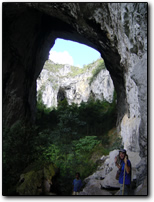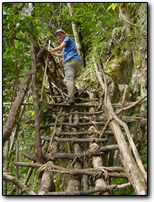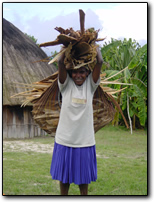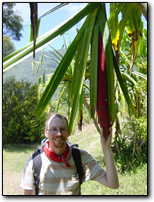Iluga
In the morning we decided to trek to the nearby cave, the one we had glimpsed on our day trip. After some discussion about how much to pay whom, we settled on a deal. Four machete-wielding boys from the village would be our guides. They led us over a rough limestone ridge and down, through forest and potato fields, into the inner canyon of the Wolo valley. There it was thick forest. We passed an abandoned coffee plantation. We heard a noise and saw a flash of color, and the boys rushed off into the bushes. They emerged with a brightly-colored red and green parrot held tightly in their hands. We thought that they might eat the bird, so we asked them to let it go. Clive tried to hold it in his hand and was bitten. The older boy took the bird and walked ahead of us on the trail. We never found out if he killed it or let it go.
 |
 |
We arrived at a giant limestone arch. The tops of the tall trees growing underneath it were still a long ways from the underside, perhaps 80m above us. After walking across a pile of guano we entered a sheer-sided amphitheater, a perfect sinkhole. At the far end was the cave. We picked our way over the jagged stones and through the undergrowth to a vantage point where the ground sloped down to the cave’s mouth. Running down the steep slope, the boys climbed over the piles of guano at the entrance to explore the interior. We stayed at our vantage point, happy to admire the cave. To return to Iluga we used a different trail. At one point we climbed a makeshift ladder constructed from tree branches and rattan vines tied to the vegetation and sheer rock wall. In Iluga, we decided to continue to Kalarin, the last town before the pass to the lake. Clive, daunted by the unknowns ahead, chose to spend another night in Iluga and return to Wamena the next day.
 |
 |
